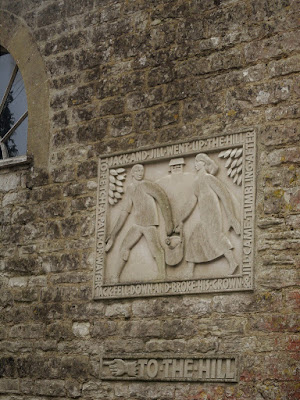First stop, Leigh-on-Mendip, at the eastern, less familiar end of the Mendip Hills. The church there, St Giles, was originally a Chapel of Ease for nearby Mells and was completed around 1350.
Its dimensions are narrow and high, but it also feels cosy and intimate, even on a drizzly grey day.
I loved the scraps of mediaeval glass in the windows (this the Great West) ...
... and the original, late 14th century bench ends ...
... and oh! that magnificent tie-beam roof, with its beautiful carvings.
This was my favourite thing, though.
Leaving Leigh-on-Mendip, I headed four and a half miles up the road to what was perhaps the main attraction of my morning's itinerary, Holcombe Old Church.
Because how could I resist visiting an ancient church, far from any village, with the sobriquet The Plague Church?
Though actually there would be no going inside, as I didn't have time to seek out one of the several keys being held in the rather distant village of Holcombe.
But it didn't matter. I was interested in the story of the old village which was buried and abandoned in the 1660s when the Great Plague arrived.
It's under these humps here, apparently.
There are assertions online that Holcombe is where the nursery rhyme 'Ring a ring o' roses' originated.
 Hmmm. My book of the origins of folk rhymes has debunked the debunking of the song as having anything to do with plague - there are pneumonic forms too, you know - but it would be good to have even a shred of evidence linking the rhyme to the village.
Hmmm. My book of the origins of folk rhymes has debunked the debunking of the song as having anything to do with plague - there are pneumonic forms too, you know - but it would be good to have even a shred of evidence linking the rhyme to the village. Maybe, thought I, the villagers claim this because the nearby village of Mells is supposed to have a connection with the rhyme Little Jack Horner. Anything they can do. Yes, that must be it.
Maybe, thought I, the villagers claim this because the nearby village of Mells is supposed to have a connection with the rhyme Little Jack Horner. Anything they can do. Yes, that must be it. The Norman arch and worn steps of the porch
Upsidedown? Back-to-front? Partially Greek? graffiti with serifs in the doorway
This is the grave of Widow Joan ? who was buried in April 1666. I wonder if she died of the plague.
Grave of Bessie Pole, aged 10; Clifford Pole, aged 8; Thomas Pole, aged 7; Eveline Long, aged 11 and Ewart Long, aged 8, who were drowned in a pond in this parish 'by the insecurity of the ice, Dec 20 1899' ...
... also of Harcourt Morely Long, who was drowned at Kilmersdon Common, July 27 1894 aged 14 months, and was buried in this churchyard.
It was raining quite hard by now, so I gave up my attempt to find the family grave of Robert Falcon Scott and headed instead for the Church of St Peter and St Paul in Kilmersdon ...
... which boasts a lych gate by Sir Edwin Lutyens. And very lovely it is too.
Unfortunately the man who'd been doing in something in the church was leaving just as I arrived, so I didn't get to look inside.
No matter. I'd spotted something interesting set into a nearby wall ...
Blimey! Another nursery rhyme!
 So, the story here is that in 1697 a local unmarried woman (Jill) fell pregnant. Shortly afterwards, the presumed father (Jack) was hit by a stone from Badstone Quarry (Very Badstone for him) and died. Jill had her baby but naturally she died not long afterwards too, the harlot, and the child was raised by villagers. It's said this is where the common local surname Gilson comes from.
So, the story here is that in 1697 a local unmarried woman (Jill) fell pregnant. Shortly afterwards, the presumed father (Jack) was hit by a stone from Badstone Quarry (Very Badstone for him) and died. Jill had her baby but naturally she died not long afterwards too, the harlot, and the child was raised by villagers. It's said this is where the common local surname Gilson comes from. Being short of both time and vinegar and brown paper, I decided not to climb the hill. That can wait for another day.


























Beautiful outing.
ReplyDelete